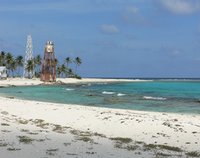Birding at Cockscomb
 Cockscomb Basin Wildlife Sanctuary, one of the 9 protected areas that is managed by Belize Audubon Society, is well known as the world's first jaguar preserve. But instead of searching the trails for tracks of the elusive jaguar I was looking up for birds.
Cockscomb Basin Wildlife Sanctuary, one of the 9 protected areas that is managed by Belize Audubon Society, is well known as the world's first jaguar preserve. But instead of searching the trails for tracks of the elusive jaguar I was looking up for birds.Israel Manzanero, the best kept secret of St. Herman's Blue Hole National Park, is an expert birder who works as a park warden for BAS. While I have a lot of past birding experiences to share, identifying the birds of Belize is new to me. I assisted Mr. Manza in teaching the warden's at Cockscomb how to improve their birding skills for monitoring and showing visitors around. There are a handful of common birds that can be identified easily, but 290 species have been recorded within the boundaries of the 128,000 acre wildlife sanctuary.
At around 5:15 AM we heard a Tropical Peewee while we enjoyed a hot cup of coffee on the verandah of our cabin; shortly afterwards, the call of a Spectacled Owl. At 5:30 AM the group met at the visitor center and by then the dawn chorus was at full volume. In the first hour I had a list of about 35 species. We hiked a trail to the riverside and looped back through the lowland jungle, covering a distance of about five miles. Before lunch, the list had grown to 82 species. I was so amazed by the quality of birding.
 In the afternoon we hiked the Waterfall Trail to seek out some birds that live at higher elevation. My goal was to break 100 before the end of the day, but the afternoon was slower than the morning's activity. We returned to the visitor center and I continued gazing into the canopy, looking for the next new species. I located Black-faced Grosbeak and Yellow-winged Tanager among the many birds we had seen earlier. My list was now at 96 but it was too dark for my binoculars to gather enough light.
In the afternoon we hiked the Waterfall Trail to seek out some birds that live at higher elevation. My goal was to break 100 before the end of the day, but the afternoon was slower than the morning's activity. We returned to the visitor center and I continued gazing into the canopy, looking for the next new species. I located Black-faced Grosbeak and Yellow-winged Tanager among the many birds we had seen earlier. My list was now at 96 but it was too dark for my binoculars to gather enough light.While chatting on the verandah after the sun had set, I heard an owl calling in the distance, identified by Mr. Manza as the Black and White Owl (97). We tried to relocate the Common Paraque we had seen the previous night but had no such luck. Then a heavy rain came down and persuaded me not to go on a night walk. It was difficult to sleep that night because one of the cabin mates was snoring as loud as a howler monkey. So I listened to the crickets calling, hoping to hear another owl in the forest, and waiting to do it all over again the next morning.
 I don't know if we reached 100 as a group that day. Mr. Manza had at least one and maybe more birds that I had not seen or heard, so it's possible. However, I was not disappointed, never before I have I recorded so many bird species in such a short time. It was also pleasant to see a few visitor from home on their winter vacation, such as the Eastern Woodpeewee, Ovenbird, American Redstart, and Red-eyed Vireo. During my visit at Cockscomb I became familiar with a lot of new birds and their vocalizations so that when I'm on my own they won't give me much trouble.
I don't know if we reached 100 as a group that day. Mr. Manza had at least one and maybe more birds that I had not seen or heard, so it's possible. However, I was not disappointed, never before I have I recorded so many bird species in such a short time. It was also pleasant to see a few visitor from home on their winter vacation, such as the Eastern Woodpeewee, Ovenbird, American Redstart, and Red-eyed Vireo. During my visit at Cockscomb I became familiar with a lot of new birds and their vocalizations so that when I'm on my own they won't give me much trouble. 








